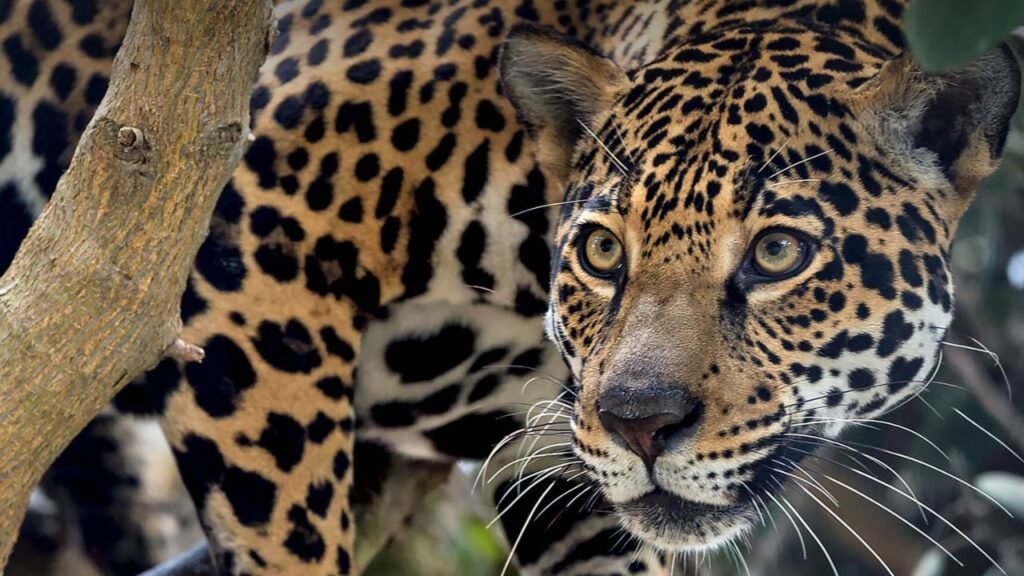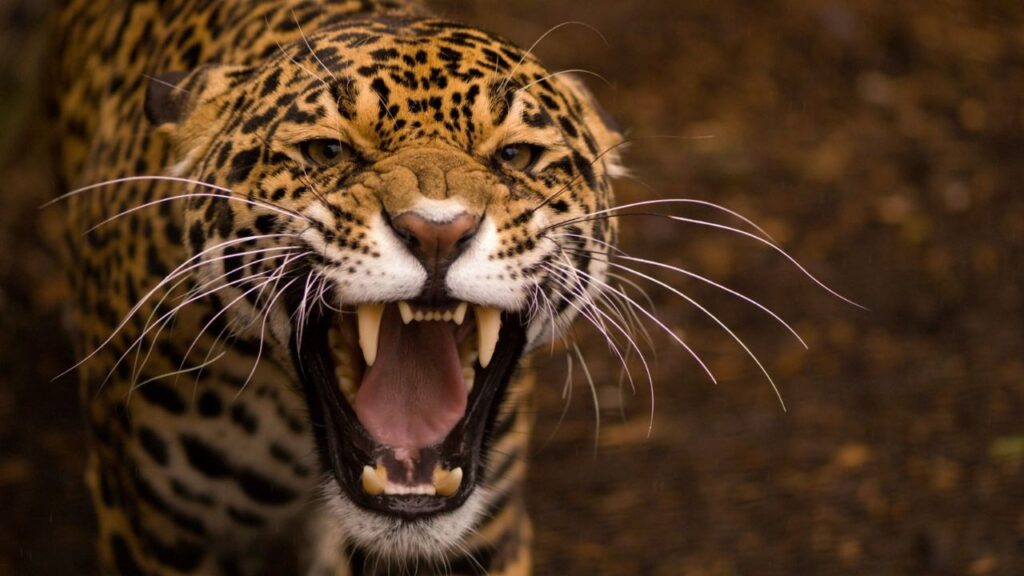Do Jaguars Attack Humans? Jaguars rarely attack humans, but when they do, it’s often due to perceived threats or territorial defense.
Jaguars, the majestic big cats of the Americas, are often shrouded in mystery and intrigue.
Known for their incredible strength, stealth, and striking beauty, these apex predators play a crucial role in maintaining the balance of their ecosystems.
However, their elusive nature and powerful presence raise an important question: Are jaguars a threat to humans?
Understanding the behavior of jaguars and the factors that might lead to human-jaguar conflicts is essential, especially as human activities increasingly encroach on their natural habitats.
Contents
Understanding Jaguar Behavior
Natural Predators and Prey
Jaguars are solitary hunters, primarily found in the dense rainforests of Central and South America. [Do Jaguars Attack Humans?]
They are opportunistic predators with a diverse diet that includes over 85 different species, ranging from deer and peccaries to smaller animals like monkeys and birds.
Their powerful jaws and sharp teeth enable them to crush the skulls or shells of their prey, a hunting technique that sets them apart from other big cats.
Despite their formidable hunting abilities, jaguars do not consider humans as natural prey. Unlike lions or tigers, which may occasionally hunt humans, jaguars are more likely to avoid human contact.
This aversion is rooted in their natural behavior, as jaguars prefer to hunt in areas where they are less likely to encounter people.
The dense forests and remote jungles they inhabit provide ample opportunities to hunt their preferred prey, reducing the likelihood of human encounters.
Territorial Instincts
Jaguars are highly territorial animals, with males establishing large territories that they fiercely defend against other males.
A male jaguar’s territory can range from 25 to 38 square miles, while females typically occupy smaller territories within these larger male territories.
Jaguars mark their territory with scent markings and vocalizations, warning other jaguars to stay away. [Do Jaguars Attack Humans?]
Territorial disputes between jaguars are common, but conflicts with humans usually arise when humans unknowingly encroach on jaguar territory.
In such cases, a jaguar may perceive a human as a threat to its territory, leading to a potential conflict. However, even in these situations, jaguars are more likely to flee than to confront a human.

Interaction with Humans
While jaguars generally avoid humans, there have been instances where these big cats have come into contact with people.
These encounters are rare and often occur in areas where jaguars’ natural habitats overlap with human settlements.
Factors such as habitat loss, deforestation, and hunting pressure can force jaguars to venture closer to human populations in search of food or new territory.
In most cases, jaguars are more curious than aggressive when encountering humans. They may observe from a distance or quietly retreat into the forest.
However, if a jaguar feels cornered or threatened, it may resort to defensive behavior, which could result in an attack. [Do Jaguars Attack Humans?]
Understanding the circumstances under which these encounters occur is key to preventing conflicts and ensuring the safety of both humans and jaguars.
Do Jaguars Attack Humans?
Frequency of Attacks
Jaguar attacks on humans are exceedingly rare. Unlike other big cats, such as tigers and lions, which have a more documented history of human attacks, jaguars are less likely to view humans as prey.
Studies have shown that jaguars are more likely to avoid human contact and will typically flee when confronted by people. [Do Jaguars Attack Humans?]
This behavior is likely a result of their solitary and secretive nature, as well as their preference for hunting in densely forested areas where human presence is minimal.
When attacks do occur, they are often the result of unusual circumstances, such as a jaguar being wounded, cornered, or provoked.
In some cases, jaguars that have become accustomed to human presence due to habitat encroachment or food scarcity may lose their natural fear of humans, leading to potentially dangerous encounters.
However, such incidents are exceptionally uncommon, and jaguars are generally not considered a significant threat to human safety.
Severity of Attacks
In the rare instances where jaguar attacks on humans have occurred, the outcomes can vary. Jaguars possess immense strength, and their powerful jaws can inflict severe injuries.
However, because jaguar attacks are typically defensive rather than predatory, they are less likely to result in fatalities compared to attacks by other big cats like lions or tigers.
Most recorded jaguar attacks involve cases where the animal felt threatened or cornered, leading to a quick and decisive defensive response.
These attacks often result in non-fatal injuries, as the jaguar’s primary goal is to escape rather than kill. [Do Jaguars Attack Humans?]
Nonetheless, due to the jaguar’s strength and agility, any encounter with this powerful predator should be taken seriously.

Factors Contributing to Jaguar Attacks
Habitat Encroachment
One of the primary factors contributing to human-jaguar conflicts is habitat encroachment. [Do Jaguars Attack Humans?]
As human populations expand, forests are cleared for agriculture, urban development, and infrastructure projects, leading to a significant reduction in jaguar habitats.
This loss of habitat forces jaguars to venture closer to human settlements in search of food and territory, increasing the likelihood of encounters.
Deforestation in the Amazon rainforest, for example, has resulted in fragmented habitats, leaving jaguars with fewer places to hunt and breed.
As a result, these big cats may come into contact with humans more frequently, particularly in areas where livestock or pets are available as potential prey.
To mitigate these conflicts, it is essential to prioritize conservation efforts that protect and restore jaguar habitats, ensuring that these animals have the space they need to thrive without coming into conflict with humans.
Human Activities
Certain human activities can increase the likelihood of jaguar attacks. [Do Jaguars Attack Humans?]
Hunting, logging, and agricultural expansion can disrupt jaguar habitats, leading to increased stress and aggression among these big cats.
Additionally, activities such as hiking, camping, or exploring in remote jungle areas can inadvertently bring humans into close proximity with jaguars.
In some cases, jaguars may be attracted to human settlements by the presence of livestock or pets, which they may view as easy prey.
Ranchers and farmers who lose livestock to jaguar predation may retaliate by hunting or trapping jaguars, further exacerbating the conflict.
To prevent such conflicts, it is important to implement measures that protect both human interests and jaguar populations, such as using predator-proof enclosures for livestock and promoting coexistence strategies that minimize the risk of encounters.
Conservation vs. Human Safety
Conservation efforts aimed at protecting jaguars have made significant strides in recent years, with many organizations working to preserve jaguar habitats and reduce human-wildlife conflicts.
However, balancing conservation with human safety remains a challenge, particularly in areas where jaguars and humans coexist. [Do Jaguars Attack Humans?]
One approach to reducing conflicts is to involve local communities in conservation efforts, promoting awareness and education about the importance of jaguars in the ecosystem.
By fostering a sense of stewardship and providing incentives for coexistence, conservation programs can help ensure that jaguars are protected while minimizing the risk to human populations.
In some cases, translocation of problem jaguars may be necessary to prevent further conflicts. This involves capturing and relocating jaguars to protected areas where they are less likely to encounter humans.
However, translocation is a complex and costly process that should be considered only as a last resort, with the primary focus being on preserving natural habitats and reducing human encroachment.

Prevention and Safety Tips
Guidelines for Avoiding Encounters
To reduce the risk of jaguar encounters, it is essential to follow certain guidelines when traveling or living in areas known to be inhabited by these big cats. Here are some tips for staying safe:
- Avoid traveling alone: When hiking or exploring in jaguar territory, always travel in groups. Jaguars are less likely to approach a group of people than a lone individual.
- Stay alert: Be aware of your surroundings, and keep an eye out for signs of jaguar activity, such as tracks, scat, or scratch marks on trees.
- Avoid dawn and dusk activities: Jaguars are most active during the early morning and late evening hours. Try to avoid outdoor activities during these times to reduce the likelihood of an encounter.
- Keep a safe distance: If you spot a jaguar in the wild, do not approach it. Maintain a safe distance and give the animal plenty of space to move away.
- Make noise: When walking through dense forests or jungle areas, make noise to alert jaguars to your presence. This can help prevent accidental encounters that may lead to defensive behavior.
What to Do During an Encounter
If you do encounter a jaguar in the wild, it is crucial to remain calm and take the following steps:
- Do not run: Running may trigger the jaguar’s predatory instincts, causing it to chase you. Instead, stand your ground and try to appear as large as possible by raising your arms and opening your jacket or backpack.
- Maintain eye contact: Stare directly at the jaguar without turning your back. Jaguars are less likely to attack if they perceive you as a threat.
- Slowly back away: While maintaining eye contact, slowly back away from the jaguar. Do not turn your back or make sudden movements. [Do Jaguars Attack Humans?]
- Use a deterrent: If the jaguar shows signs of aggression, such as growling or crouching, try to scare it away by making loud noises, throwing objects, or using a deterrent like bear spray.
- Seek shelter: If possible, seek shelter in a nearby building, vehicle, or other structure until the jaguar leaves the area.
By following these guidelines, you can reduce the risk of a dangerous encounter and protect both yourself and the jaguar.
See Also: Do Hyenas Attack Humans? The Hidden Danger!
FAQs
How often do jaguar attacks on humans occur?
Jaguar attacks on humans are extremely rare, with most incidents occurring in remote jungle areas where jaguar habitats overlap with human activity.
Are jaguars more dangerous than other big cats?
Jaguars are not necessarily more dangerous than other big cats like lions or tigers. However, their powerful jaws and territorial nature make them formidable predators.
Can jaguars be safely observed in the wild?
Yes, jaguars can be observed safely in the wild, provided that proper precautions are taken, such as maintaining a safe distance and avoiding solitary travel.
What are the signs of a jaguar nearby?
Signs of a jaguar nearby include fresh tracks, scat, scratch marks on trees, and the presence of carcasses from recent kills. [Do Jaguars Attack Humans?]
Are there any cultural beliefs about jaguars and human safety?
Many indigenous cultures view jaguars with reverence, often associating them with strength, power, and protection. However, they also recognize the importance of respecting these animals and avoiding unnecessary conflicts.
Conclusion: Do Jaguars Attack Humans?
Jaguars are magnificent creatures that play a vital role in maintaining the balance of their ecosystems.
While the risk of a jaguar attack on humans is low, understanding these big cats’ behavior and the factors that may lead to conflict is essential for ensuring both human safety and the conservation of jaguar populations.
By respecting their habitats, minimizing human encroachment, and following safety guidelines, we can coexist peacefully with these powerful predators and help secure their future in the wild.

Hello, I am Rosa Ellis, a mother of two and a wildlife blogger. I grew up in New York City, but I love exploring forests. I’ve traveled to places like Yellowstone National Park and the Amazon Rainforest to see animals up close. I know a lot about animal behavior and which animals can be dangerous to humans. Thanks for visiting my blog!

